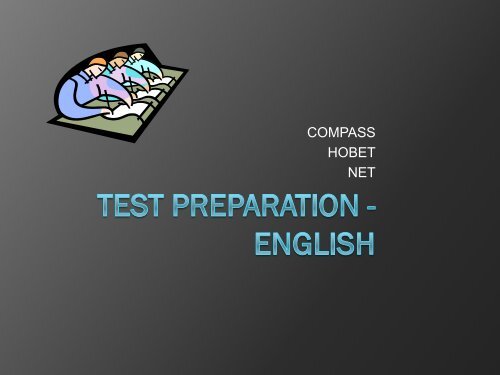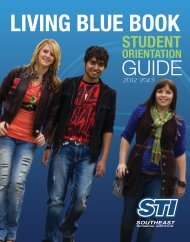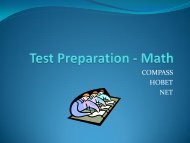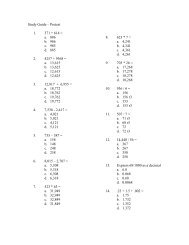English PowerPoint - Southeast Technical Institute
English PowerPoint - Southeast Technical Institute
English PowerPoint - Southeast Technical Institute
- No tags were found...
You also want an ePaper? Increase the reach of your titles
YUMPU automatically turns print PDFs into web optimized ePapers that Google loves.
COMPASSHOBETNET
Top 10 Test Taking Strategies10. Read all directions and questionscarefully9. Attempt every question – it may not beas difficult as it appears8. Anticipate the answer – if it isn‟t there,test the other answers7. Use logical reasoning –watch for absolutes such asalways, never
Top 10 Test Taking Strategies6. Watch for sequences – first, last, initial5. Read each answer carefully – many aretrue statements but only one is the“right” answer4. Consider all the alternatives – wait tomake a decision3. Make sure you are ready to sit downand concentrate on the test
Top 10 Test Taking Strategies2. Select your answer and then re-readthe question to make sure that youunderstood it correctly1. Relax! Keep calm. And do your best!
Structure of the COMPASS Test The test is not timed The computer will generate thequestions individually The <strong>English</strong> essays contain many errorsin punctuation, grammar, and style Carefully read the essays When you locate an error, choosethe best option for rewriting the essay
Critical Reading Demonstrate your ability to “readbetween the lines” You must determine the meaning andpurpose of what you have read You need to look for “hooks” to attachnew information You need to determine the main idea ofthe paragraph and the central theme
Reading for the Main Idea Topic statements usually occur at thebeginning or the end of the paragraph The main idea• Includes the topic of the paragraph• Identifies how this topic is or does something• Serves as an umbrella structure for thedetails of the paragraph
Errors in Identifying Main Idea Too narrow – It ignores the wider rangeof details introduced in the paragraph Too general – It goes past the detailsthat are presented in the paragraph False statement
Examples of Main Idea Questions Which states the main idea of this paragraph? Which is the best statement of the main ideafor the paragraph? Select the main idea for this paragraph. The main idea of this paragraph is bestrevealed by which statement? Identify the main idea for the paragraph.
Inferential Reading When you draw a conclusion from theparagraph, you are making an inference The conclusion you draw is not stated wordfor word in the paragraph The conclusion you draw is supported bydetails in the paragraph
Inferential Reading The author of the paragraph provides informationin the text of the paragraph In addition to the literal information in theparagraph, the author also is implying something You use the text to create an inference –something you believe to be true based on the text
Examples of Inferential Questions Identify an inference that can be derived fromthis paragraph. Which is an inference base on the paragraph? Which statement is true based upon theparagraph? Based on this paragraph, which statement istrue? Identify a conclusion that can be drawn fromthis paragraph.
More Examples of Inferential Questions Which factor in this paragraph supports the topicof soil control? Which describes the attitude of the spectators inthis paragraph? How is sleepwalking characterized in thisparagraph? How does Faulkner portray Emily‟s manservant?
Themes of a Reading The theme is a phrase stating what theparagraph is about Sample Theme Questions• Which would be a statement of theme for thisparagraph?• Identify the central, unifying theme of the lastthree paragraphs?• What is the common theme of the article?
Purpose of a Reading Make a value judgment about why aselection was written Sample “Purpose” Questions• Identify the purpose of paragraphs J-L• What is the purpose of paragraph M• Which is the best statement of purpose forparagraph Q
Predicting Outcomes Predict an action, based upon the paragraph Questions• Which would be an outcome from paragraph F• Which is a true statement based on these twoparagraphs• Which would be an outcome resulting fromparagraph G
Reading Rate Between 250 and 450 words per minuteand a Comprehension level of 70%• Normal or Average (Instructional Rate) Less than 250 words per minute• You may be unable to complete all the readingrequirements (Frustration Rate) Above 450 words per minute• Not necessary for college (Independent Rate)
Increase Your Reading Rate Keep in mind the purpose for reading• Don‟t let your mind wander• Analyze the results you wish to get from reading Read for the main idea• Don‟t get stuck on one specific word Be Flexible• Faster is not always better• Preview the question and then skim rapidly throughparagraph
<strong>English</strong> Grammar Websites http://odl.vwv.at/english/odlres/res8/Grammar/grammar.htm http://englishgrammar101.com/Lessons/Default.aspx http://www.englishhorizon.com/grammar.htm http://www.dailygrammar.com/archive.shtml http://www.english-the-easy-way.com/index.html http://web2.uvcs.uvic.ca/elc/studyzone/330/grammar/index.htm http://web2.uvcs.uvic.ca/elc/studyzone/grammar.htm
Subject/Verb agreement Singular subjects take singular verbs• Most singular verbs end in „s‟: He thinks, She has, Thatwas, She runs, He sings Plural subjects take plural verbs• Most plural verbs do not end in „s‟: They think,They have, Those were, The birds sing, The dogs bark Remember: There is only one „s‟ endingshared between subject and verb• Plural nouns end in „s‟• Singular verbs end in „s‟
The verb ‘to sing’
Subject/Verb Agreement Exceptions of the „s‟ rule• Verbs used with I and singular you○ I think, you think, I work, you work (present tense) All past tense verbs have the same form forboth singular and plural• I went, They went; He carried, We carried Exception to this rule is the verb “to be”• I was, we were; It was, They were
Verb Tense - Presenthttp://www.englishpage.com/verbpage/verbs1.htm
Correct Verb Tense
Past Tense Verbshttp://www.englishpage.com/verbpage/verbs3.htm
Present Perfect Tense Verbshttp://www.englishpage.com/verbpage/verbs7.htm
Irregular Verbshttp://www.englishpage.com/irregularverbs/irregularverbs.html
Intervening Phrases Be careful of intervening phrases where thesubject and the verb are not together Examples• Each of the girls has her own bicycle.• Every one of the workers wants more money.• Few of my family really understand me.• Both of your excuses sound plausible.
Indefinite Pronouns Singular Pronouns• Each, everyone, anyone, someone, everyone,anybody, somebody, and everybody Plural Pronouns• Several, few, both and many Singular or Plural - Generally single but could be plural• Some, any, none, all and most
Pronoun Examples Some of the money was missing Some of the dimes were missing All of the fruit looks ripe All of the cherries look ripe Most of the book was interesting Most of the books were interesting
Subjects Joined by AND Subjects joined by and take a plural verb• A truck and a convertible were in the ditch• The walls and the ceiling were beautifully decorated Except when the items are considered one unit• Macaroni and cheese is the special today• The Stars and Stripes is our national emblem
Subjects Joined by OR/NOR Singular subjects joined by or/nor take a singularverb• My brother or my sister is likely to be at home• Either John or Jim is sure to know the answer When a singular and a plural subject are joinedby or, the verb agrees with the nearer subject• Either the judge or the lawyers are wrong• Better: Either the judge is wrong or the lawyers are.
Collective Nouns Collective nouns names a group: crowd,committee, jury, class, etc. Collective nouns take a plural verb whenreferring to individual members Collective nouns take a singular verb whenreferring to the group as a unit
Collective Noun Examples The crowd were fighting for their lives. The crowd was an orderly one. The team were talking over some new plays. The team was ranked first in the nation. The family have agreed among themselves topresent a solid front. The family is the basic unit of our society.
Objective Form Determining the object – what or whom is theaction verb referring to• I saw her• Him, I remember well Pronoun used with a noun.• Determine the correct verb by eliminating the nounnext to it• They blame us pedestrians. (NOT we pedestrians)
Prepositional Objects Prepositions have objects• At home, from him, to Chicago Errors often happen when the object iscompound Omit the first object to determine the correctverb• WRONG: Give the message to either Belle or she.• RIGHT: Give the message to either Belle or her.
Who or Whomhttp://www.englishpage.com/minitutorials/who_whom.htmlhttp://www.protrainco.com/info/essays/pronouns.htm Guidelines for Interrogative Pronouns:• If you can substitute he or she then it should be who○ (Who/Whom) left his books here?He left his books here. So Who is correct.• If you can substitute him or her then it should be whom○ Mary called (who/whom)?Mary called her. So Whom is correct.• Whom is always correct when used after a preposition
Who or Whom continued• The new teacher, (who/whom) has takenMr. Green’s position, came from SouthCarolina• (Who/Whom) has taken Mr. Green’sposition” is a subordinate clause• (who/Whom) is the subject clause• Therefore you would use the nominativeform, WHO
Examples – Who/Whom “The new teacher, (who, whom) I met today, camefrom the South.”• Who/whom is located in a subordinate clause• “I” is the subject of the clause• “met” is the verb• (who, whom) is the object of the verb• Therefore, you would use the objective form (whom)• I met “him” not I met “he”, so use the objective case (whom)
Examples of Who/Whom Does anyone know (who, whom) the newteacher is?• (who/whom) is located in the subordinate clause• “Teacher” is the subject of the clause• “is” is the verb• (who, whom) is a predicate nominative• Use the nominative form (who)
Examples of Who/Whom I do not remember (who, whom) I lent the bookto.”• (who/whom) is located in the subordinate clause• “Book” is the subject of the clause• “lent” is the verb• (who, whom) is the object of the preposition “to” Use the objective form (whom)
Pronouns in Incomplete Construction Occur most often after the words “than” and “as” To determine which pronoun to use, completethe construction of the sentence• The captain played better than (he/him).○ The captain played better than he played.• Philip is more popular than (he, him) is.○ Philip is more popular than he is popular.
Appositives An appositive is a noun or pronoun (often withmodifiers) set beside another noun orpronoun to explain or identify it.• Example: Your friend Bill is in trouble.• “Bill” is in apposition with “your friend” Appositives take the same case as the wordthat it is in apposition with
Appositives Two freshman, Pete and (he/him), made the bestspeeches.• “Pete and (he/him)” are in apposition with “freshman”which is the subject of the sentence• Use the nominative case (he) The truant officer was chasing two boys, Pete andhim.• “Pete and him” are in apposition with “boys”• “boys” is the object of the verb “was chasing”• Use the objective case (him)
Principle Part of a Verb There are four basic forms• Infinitive• Present Participle• Past• Past Participlework(is) workingworked(have) worked Regular Verbs past and past participleare formed by adding -ed
Irregular Verbs An irregular verb is one that forms itspast and past participle in some otherway than a regular verb Infinitive Past Past Participle Swim swam (have) swum Write wrote (have) written Hit hit (have) hit Refer to handout
Other Errors “This here” and “that there”• Substandard: This here book is easy to read.• Standard: This book is easy to read “When” and “where” are not used in definitions• Wrong: An atlas is where maps are printed.• Right: An atlas is a book of maps
Other Errors Which – only refers to things Who – only refers to people That – can refer to both things and people• This is a book (which, who, that) you would enjoy.• There is a girl (which, who, that) has talent.
Sentence Fragments A complete sentence has a subject andverb and expresses a complete thought• Incomplete – After the flood the barn roof inthe yard. (No verb)• Incomplete – After the flood the barnroof lying in the yard. (No verb)• Complete - After the flood the barn roof layin the yard.
Run-on Sentences Occur when two sentences are joined by acomma or when punctuation is omitted• Example: The choice of a camera is difficultthere are many good ones on the market.• Solution:○ Create two sentences: The choice of a camera isdifficult. There are many good ones on the market.○ Use a conjunction: The choice of a camera is difficult,but there are many good ones on the market.○ Use a semi-colon: The choice of a camera is difficult;there are many good ones on the market.
Capitalization Capitalize proper nouns and proper adjectives• Michael Brown, Missouri River Capitalize geographical names• United States, South Dakota, Park Avenue Capitalize names of organizations, businessfirms, institutions and government bodies• Spanish Club, Ford Foundation, Congress Capitalization of brand names• Coca-Cola, Fritos
Capitalization Capitalize the names of historical eventsand periods, special events, andcalendar items• French Revolution, World Series, ChristmasEve Capitalize names of nationalities,races and religions• Caucasian, Roman Catholic, Indian Capitalize words referring to a deity• Lord, Allah, God, Jesus, the Almighty
Capitalization Capitalize the names of ships, planes,monuments, awards, and any otherparticular places, things, or events• DO NOT capitalize the names of schoolsubjects, except languages• Purple Heart, <strong>English</strong>, math, art, History III Capitalize the title of a person when itcomes before a name• Dr. Smith, General Santos, President Bush
Capitalization Capitalize a word showing family relationshipswhen used with a person‟s name but not whenpreceded by a possessive• Uncle Ellis, Cousin Randy, my cousin Rob, Pat‟sbrother, your mother, Aunt Margaret Capitalize the first word and all subsequentimportant words in titles of books, periodicals,poems, stories, articles, documents, movies,paintings, and other works of art• Treaty of Rome, A Tale of Two Cities
Basic Spelling Patterns In a word of one syllable ending in asingle consonant preceded by a singlevowel, you double the final consonantbefore adding a suffix or ending whichbegins with a vowel or the suffix• Begging• Sitting• Scrubbed• Clammy• Skinny
Basic Spelling Patterns Double the final consonant before adding asuffix beginning with a vowel, if the word• Has more than one syllable,• Has the accent on the last syllable• Ends in a single consonant preceded by a singlevowel○ Equipped○ Controllable○ Occurring○ Compelled
Basic Spelling Patterns Do not double the final consonant before addinga suffix beginning with a vowel, if the word• Does not have the accent on the last syllable• Or if the word ends in a single consonant which is notpreceded by a single vowel○ Differed○ Concealing○ Designed○ Galloping
Basic Spelling Patterns Do not double the final consonant if• The accent of the root word falls back on anothersyllable when the suffix “ence” is added○ Prefer to Preference○ Refer to Reference○ Confer to Conference
Basic Spelling Patterns Whenever you add a suffix, beginningwith a vowel to a word that ends with asilent e, you usually drop that e beforeadding the suffix• Writing• Saving• Noticed• Scheduled
Practice Test Turn to page 107 for Practice Test A:Reading Comprehension• Complete test reviewing the rules that wereset forth in the <strong>PowerPoint</strong> presentation Turn to page 126 for Practice Test B:Reading Comprehension• Complete test independently







